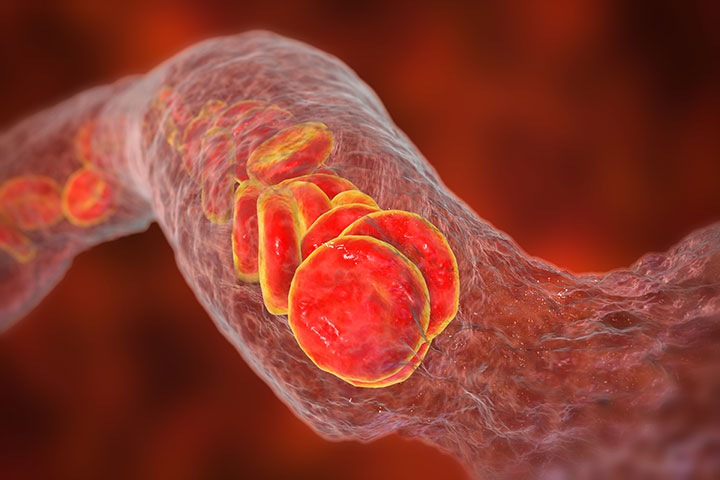Prompt recognition of subtle signs saves patient’s life.
Key Points:
- Patients who experience an aneurysmal subarachnoid hemorrhage (aSAH) require frequent neurologic assessments to monitor for vasospasm.
- Vasospasm occurs in up to 70% of patients with aSAH and frequently presents as subtle neurologic changes.
Mary Smith, a 43-year-old patient with hypertension, diabetes, and a history of smoking, is transferred from the neurosurgical ICU to the neuroscience stepdown unit 10 days ago after obliteration of an aneurysm that caused a subarachnoid hemorrhage. She was taking adequate fluid by mouth, so her maintenance fluids were discontinued yesterday.
You observe that she seems restless and is moving constantly. She’s picking at things in the air and asks whether you can see the fireflies she’s collecting. When you say you don’t see them, she uncharacteristically curses at you.
You complete a neurologic assessment of Mrs. Smith, and she answers all orientation questions correctly; her Glasgow Coma Score is 15. Her pupils are equal and reactive to light. To assess for pronator drift, you ask Mrs. Smith to hold both arms straight out. You note weakness and drift in her right arm. Your check of vital signs finds that her BP (105/75 mmHg) is lower than what it was previously. Other vital signs include respiratory rate 18 breaths per minute, pulse 95 BPM, pulse oximetry 92% on room air, and normal sinus rhythm. You also check her intake and output for the last 24 hours and note that she is “dry” with her fluid volume intake (500 mL) less her output (1,000 mL).
You recognize that Mrs. Smith may be experiencing vasospasm as a complication of her subarachnoid hemorrhage. You elevate the head of the bed and immediately contact the neurosurgeon.
On the scene
You ensure that Mrs. Smith has a patent I.V. and frequently assess her vital signs and neurologic status. The neurosurgeon orders I.V. normal saline to maintain euvolemia and 60 mg of nimodipine every 4 hours. A transcranial doppler ultrasound detects increased blood velocities. The neurosurgeon orders a CT angiography, which shows significant vasospasm.
Outcome
Mrs. Smith is transferred back to the neurosurgical ICU for induced hypertension treatment with I.V. norepinephrine and euvolemia maintenance. The nurses assess Mrs. Smith’s neurologic status every hour, and daily transcranial dopplers are ordered. The neurosurgical team is prepared to perform a balloon angioplasty or administer intra-arterial vasodilators if the vasospasm worsens, but these interventions aren’t needed. Mrs. Smith is discharged 1 week later.
Education
Vasospasm is a serious complication after an aneurysmal rupture causes a subarachnoid hemorrhage; this complication occurs in up to 70% of patients. Four to 14 days after initial rupture of the aneurysm, the blood clot begins to break down, irritating surrounding tissue and causing it to spasm and narrow (vasospasm). Vasospasm can lead to delayed cerebral ischemia (DCI), which occurs in up to 46% of patients who’ve had an aneurysmal subarachnoid hemorrhage and frequently results in poor outcomes and mortality.
Vasospasm can begin as early as 3 days after the subarachnoid hemorrhage, reaching a peak at days 7 to 8; however, vasospasm can occur as late as day 21. Patients with hyperglycemia and those younger than 50 years have an increased risk of vasospasm. Common symptoms include decreased level of consciousness, focal neurologic deficits, and other nonspecific behaviors, such as restlessness and impulsivity. Vasospasm typically is treated with hemodynamic augmentation via induced hypertension and euvolemia maintenance.
Nurses must learn to identify the subtle changes in a patient’s status to ensure prompt intervention. Your early detection and treatment saved Mrs. Smith’s life.
*Name is fictitious.
Staci Reynolds is an associate professor at Duke University School of Nursing and a clinical nurse specialist at Duke University Hospital in Durham, North Carolina.
References
Censullo J, Al Firikh AAW, Mulkey M, McNett, M, Livesay S, Ovando R. Nursing Care of the Patient with Aneurysmal Subarachnoid Hemorrhage. American Association of Neuroscience Nurses. 2018. aann.org/uploads/Publications/CPGs/Nursing_Care_Patient_Aneurysmal_CPG_SAH_final2.pdf
Connolly Jr ES, Rabinstein AA, Carhuapoma JR, et al. Guidelines for the management of aneurysmal subarachnoid hemorrhage: A guideline for healthcare professionals from the American Heart Association/American Stroke Association. Stroke. 2012;43(6):1711-37. doi:10.1161/STR.0b013e3182587839
Doerksen K, Naimark B. Nonspecific behaviors as early indications of cerebral vasospasm. J Neurosci Nurs. 2006;38(6):409-15. doi:10.1097/01376517-200612000-00004
Francoeur CL, Mayer SA. Management of delayed cerebral ischemia after subarachnoid hemorrhage. Crit Care. 2016;20(1):277. doi:10.1186/s13054-016-1447-6
Kumar G, Alexandrov AV. Vasospasm surveillance with transcranial doppler sonography in subarachnoid hemorrhage. J Ultrasound Med. 2015;34(8):1345-50. doi:10.7863/ultra.34.8.1345
Key words:
Aneurysm, Subarachnoid hemorrhage, Vasospasm, Neurologic assessment


















